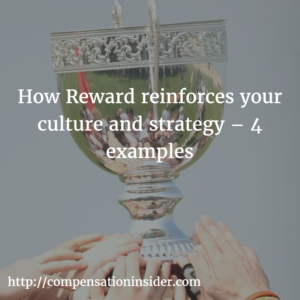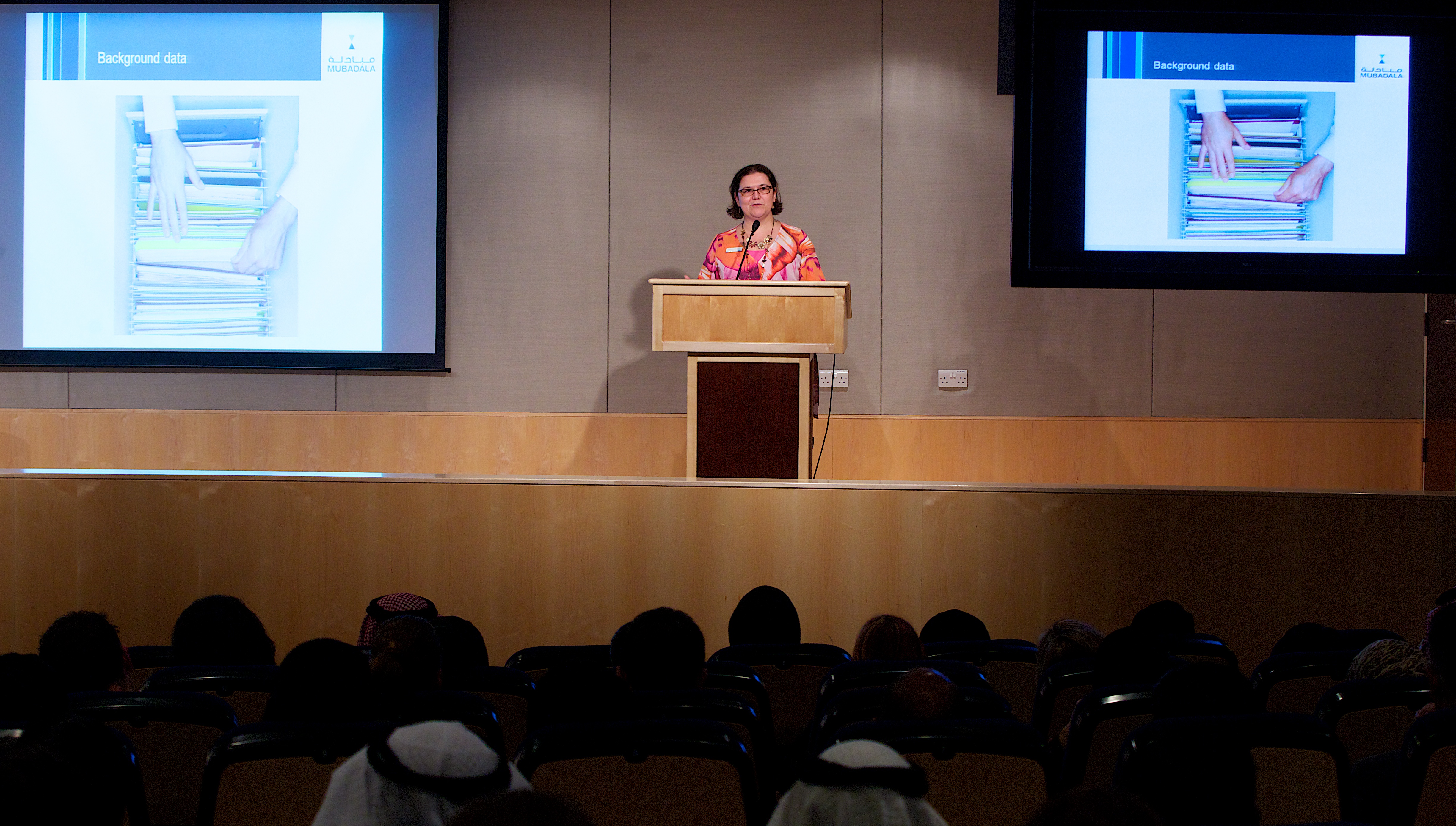My good friend Sylvia Doyle is a terrific independent Rewards consultant based in the UK.
A few days ago, she produced an interesting piece on the CIPD Reward Blogger’s blog called “I have a question for you”. Her post raises interesting points about culture and strategy. As she wrote :
“As HR and reward professionals, it should be second nature that people and reward management strategy and practices are developed and aligned to the culture and strategy. However some organisations ‘get stuck’ in articulating or redefining their values – the outcomes which can range from, on one end being consigned to the ranks of a cosmetic branding exercise while the most successful ones reflect and reinforce the ‘how’ behaviours of culture with the ‘what’ aspects of moving the business plan forward.”
Her article emphasizes that culture and strategy are sometimes unclear, or changing. Organisations may get “stuck” trying to articulate their values. Getting buy-in is difficult if employees have not been involved in preparing the design of whatever needs to be changed in the company. So she asks :
How do you use reward to help reinforce your culture and strategy?
This is a great question, one that we (HR and Reward pros alike) claim to always take into account when we implement new programs. After all, don’t we always say “designed to support the business strategy and needs” ?
But how do we actually prove that ?
You see, I’m a practical girl. I’ve worked at some really great companies like Apple, Microsoft, Philips, Majid Al Futtaim…. But to be honest, even in these great companies, it was rare to have a vision, mission statement, and values that were truly “owned” by the staff – and even by senior management – in the way that they were written. Of course a positive, driven and clear culture was shared, but the words used to describe it by employees were not the same as the “official” ones. And that’s in the “good” companies – imagine what if felt like in other organisations where the culture might not have been as supportive or commonly shared…
So – take out the wording of your values and culture. Also take out the wording of the actual strategy, because let’s face it – very few people actually understand and know it, if the “strategy” consists in a 600-page report compiling the 5-year business plans of a dozen or so Divisions in a conglomerate.
So what’s a Reward pro to do in order to support the culture and strategy of her organisation ?
Well, as I said, I’m a practical girl. My approach has always been simple. I did not focus much on the official words. Instead, I spent some time with senior management and listened to their challenges, what they were trying to achieve, what they felt was missing. And then I tried to help them fill some of the gaps through the design of our Rewards approaches.
Want some examples ?
(Please note : of course I do not contend that these Reward measures can single-handedly shape a company culture or ensure the achievement of objectives. But as you will hopefully see, they contributed directly to solving the challenges of the organisation at that time).
Example 1 : Creating a “one company” culture
The situation : it was a conglomerate with multiple business lines, including one that generated a lot of cash, predictable, growing, with fast cycles – and another business that required very risky, long-term investments but with huge return potential.
The businesses could not have been more different yet were intertwined, needing to collaborate closely in order to be successful. The CEO wanted to support the fact that this was a Group with a common vision and objectives, not a simple collection of individual businesses with potentially competing objectives.
One of the things we did : we changed the design of the annual incentive. For top management, the portion linked to overall Group results was the heaviest one, significantly higher than the portion linked to the achievements of their own business. This helped them focus on the fact that the Group needed to succeed, not just their Division, and that they were all responsible for that success. The Long-Term Incentive award criteria focused solely on Group metrics (different from the ones used in the annual incentive scheme).
The results : The “One” Group culture spread, collaboration improved, with more creative, compromise approaches being developed that might not even have been thought of before.It helped top management agree to large investment decisions that were supported by the CEO, despite the fact they might hurt the “cash cow” in the short term but were crucial for the upcoming business line.
Example 2 : Support nationalisation efforts in the GCC
The situation : it was a GCC company where expat employees were scared of losing their job if they grew the skills of the local Nationals.
The government focused a lot on nationalisation efforts, and articles in the press highlighted less and less expat-friendly approaches, combined with rumours and fear due to the fact that many of the decrees and directives were not fully available, not even in Arabic, and even less so in English.
Two of the things we did : all people managers received a mandatory objective in their performance appraisal, based on how well they ensured that Nationals were well developed and trained in their team, with quarterly or annual reporting on quantifiable/trackable topics such as : nationalisation quota and trend in your team, did you have a development meeting with all Nationals in your team etc ?
The second thing was the introduction of a “Best expat manager of a National employee” award in the annual recognition scheme, to emphasise the value that these expat line managers bring to the organisation. On top of the winner, all nominees were celebrated in order to encourage all line managers to grow their National team members.
The results : Better job satisfaction reported by the Nationals, especially driven by a clearer understanding of their development opportunities (and responsibilities). Return to previous productivity and engagement levels for expats as well as Nationals. Some spontaneous nationalisation initiatives sprung up and were showcased throughout the whole organisation to help spread a positive growth model.
Example 3 : Maintain main source of revenue and be perceived as a better company by clients
The situation : it was a company where the Major Account sales people were very badly perceived by the customers.
The sales guys were shifting accounts too often (so the clients had to re-explain all their history and specifics to the new account manager all the time), they were “pushing” sales too hard, and then not following up on the account once the order was placed. These very large clients were, for example, car manufacturers, pharmaceutical companies etc with global operations and multiple lines of business. They made a corporate agreement to buy X products over 18 to 24 months with the Major Accounts sales rep, and then, the actual implementation of this agreement was managed by local sales reps in all countries, who sold locally within these Terms & Conditions, but also placed additional products and services where needed.
Major Accounts represented a very significant part of the company’s income, so having them unhappy about the sales reps was a real problem.
Some of the things we did : in the sales incentive design, we amended the rules about the management of accounts and territories to restrict the possibility of changing accounts right after signing a major contract. We also amended how the payout was calculated, with more balance between big contract selling, and follow-up of service and delivery – this was to ensure that the sales rep did not “disappear” from the client’s life after the contract was signed.
We changed the rules that govern eligibility for promotion, to ensure that a sales rep would not be promoted away from the account too early. Furthermore, we introduced a systematic, semi-annual customer satisfaction survey which greatly impacted the salesperson’s performance rating and therefore their career development (but not their short-term incentive payout). Of course, we had to balance the introduction of these more restrictive rules by a review of the split between fixed and variable pay.
The results : the company stopped losing major accounts. Customer satisfaction increased very quickly. Feeling that they had less pressure on “big sales”, the Major Accounts reps focused on more quality support, relationship-building with the clients, and eventually we even saw a significant improvement in employee engagement, which was nice side-effect that we had not anticipated.
Example 4 : Ensure sustainable growth and knowledge transfer in the markets of the future
The situation : it was a company that needed to attract experienced, educated talent in emerging countries that were considered unsafe at the time, for example in Algeria or Lebanon.
Western expats were few to accept to relocate there due to the risks of abduction or other physical harm to themselves or their family. The rare ones who considered the assignment, were very costly to the organisation, with not only Cost of Living allowance but also Hardship and even Security allowances. Nationals who were living in France or Canada, refused to go back to their home country, not only for the same security reasons, but also because they were offered a pure local package on the basis of their passport.
Two of the things we did : we created a new category of assignment in the global mobility policy. “Local +” hire on semi-permanent conditions, with a local contract but additional benefits and allowances such as housing, education, hardship in some cases, but no security allowance. The additional benefits started to phase out after 5 years, which coincided with the end of a traditional expatriation package with Social Security detachment (3+1+1 years). Basic pay was adjusted to reflect the fact that these Nationals were coming from countries with current high salaries (in short, they were paid more on basic than a pure local National).
The second thing was that we created a special incentive for these senior talent, to encourage them to hire and grow local talent and prepare the next generation of local leaders. This gave us not only a talent pipeline, but also gave hope for the local+ assignees that if they wanted to, it would be easier for them to relocate back to Europe or Canada as they could be replaced.
The results : We offered these local+packages not only to “returning” Nationals, but also to external candidates to key senior positions in these emerging markets, and filled all positions within the targeted deadline. Looking back, former colleagues told me that very few of these local+ employees actually asked to return to western countries, or even actually left the company at the end of the 5-year period. Success !
I hope these 4 examples will help you see how Reward can reinforce the culture and strategy of the organisation, and I would love to read some of your examples, so please share them in the comments section !




Informative article
Thanks Betzi !
Thanks for pragmatic illustrations…that HR practitioners need not worry about getting the design of vision, mission.. right. But that we can propose and practice some effective measures and thereby get everyone on board.
Regards.
Philip
Glad you found it useful Philip !